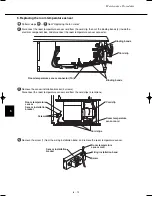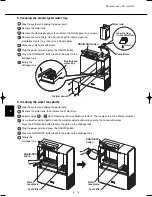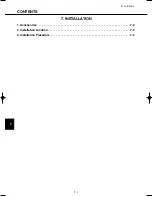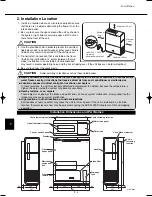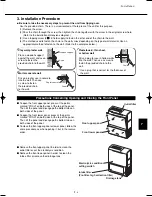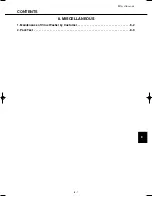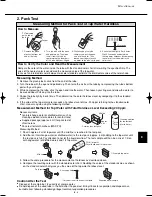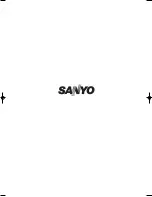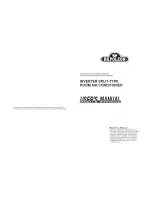
8
Miscellaneous
Nature of Test
The principle of this method is silver nitrate color comparison, allowing easy measurement of the chloride
concentration in various types of sample water, for example, industrial waste water and environmental water.
Cautions
1. The Chloride (Low Range) Pack Test allows the measurement of chloride ions (Cl
-
-
) in low concentraions.
2. If the chloride concentration is higher than 50 mg/L, a precipitate will occur. Always shake the tube lightly before
comparing the reaction color.
3. If the chloride concentration is higher than 150 mg/L, the precipitate will be white. If the chloride concentration
is approximately higher than 500-1000 mg/L, the precipitate will be more significant and may lighten the
reaction color. Especially pay attention if the concentration is higher than 1000 mg/L. If you expect a high
concentration of chloride, dilute the sample water before the measurement using distilled water. Usually, the
chloride concentration of river water or tap water is 20 – 50 mg/L.
4. To measure chloride used for water disinfection (residual chlorine from sodium hypochlorite, for instance), it is
recommended that you use the following products:
Residual Chlorine (Free) Pack Test, ref: WAK-CIO.DP
Residual Chlorine (High Range) Pack Test, ref: WAK-CIO (C)
5. The normal pH range is 6 – 10. If necessary, adjust the pH level using diluted sulfuric acid or sodium hydroxide
solution.
6. Ensure that that Pack Test tube is filled to the half-way point.
7. Partially un-dissolved reagent will not affect the measurement.
8. Keep the sample temperature in the range 15 – 30°C. Lower temperatures necessitate a longer reaction time.
9. Read the test under a “daylight type” lamp.
10. Be careful to prevent reagent spillage.
Standard colors
The standard colors on the chart were determined using colors from standardized solutions. Bromide ions, iodide
ions, cyanide ions and phosphate ions react with the reagent, inducing color changes.
Sulfite ions, thio-sulfate ions, and sulfide ions can interfere with the color results. These sulphur compounds can be
oxidized with hydrogen peroxide. Because of the high chloride concentration, the Chloride (Low Range) Pack Test
is not suitable for seawater samples.
8
- 4
K-1
“Cl(D)” i
n
dicated
o
n
the tab of the t
u
be
P
u
ll o
u
t
P
u
ll o
u
t the pla
s
tic
s
tick from the e
n
d of the t
u
be
3
.
T
u
r
n
the t
u
be with the ope
n
e
n
d
poi
n
ted
u
p. The
n
force the air from
the t
u
be by compre
ss
i
ng
the lower
part of the t
u
be with yo
u
r fi
ng
er
s
.
4.
S
hake the t
u
be 5 or 6 time
s
.
After o
n
e mi
nu
te, verify the
t
u
be by compari
ng
it to the
s
ta
n
dard color chart.
6.
1 mi
n
1 drop
S
hake
1. Fill the vial
u
p to the fir
s
t li
n
e
(1.5ml) with the water
s
ample.
Add o
n
e drop (–0.065mL) of
K-1 rea
g
e
n
t.
2. P
u
t o
n
the cap a
n
d
s
hake
the vial a few time
s
.
While keepi
ng
the t
u
be compre
ss
ed,
p
u
t the ope
n
e
n
d i
n
to the water.
The
n
loo
s
e
n
yo
u
r fi
ng
er
s
to
su
ck
u
p water to the t
u
be’
s
mid poi
n
t.
5.
I
ns
ert the Pack Te
s
t
i
n
the
s
lot.
How to Measure
How to Read the Test
After the reaction time, compare the color of the tube with the standard color chart.
The nearest color indicates the measured value of the sample. A color between two standard colors indicates a
value between the two standard values. Estimate accordingly to determine the chloride concentration.
Handle with Care
1. Keep the Pack Test in a cool, dry and dark place.
2. The Pack Test tube can be disposed of with domestic garbage.
3. Use the package as soon as possible.
Do Not Spill the Tube Contents
Eyes
: Immediately flush eyes with water for at least 15 minutes. Consult a physician.
Ingestion : Drink a large glass of milk or water and induce vomiting.
Skin
: Flush skin with water.
In case of doubt, consult a physician.
Measuring Method for Chloride Pack Test
07-032 VW-VF10BG_TD 2/15/07 11:25 AM Page 4

